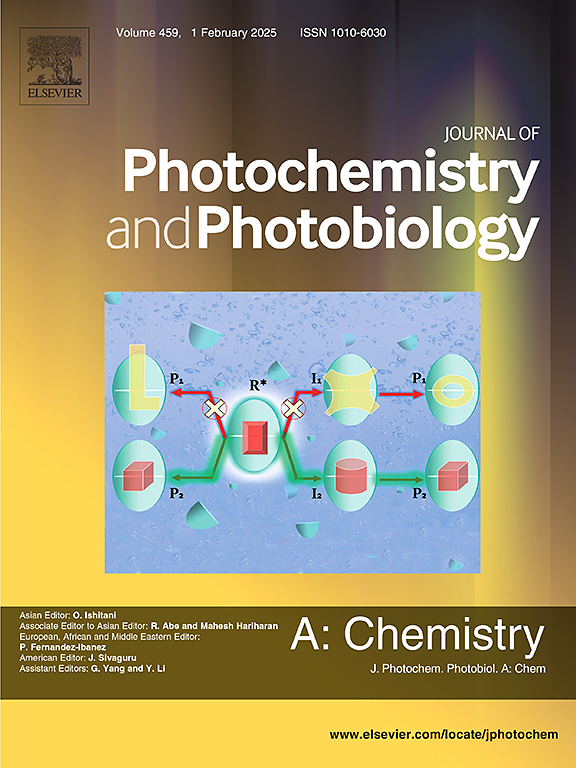A novel iodine-mediated FRET sensor for the assessment of total antioxidant capacity
IF 4.1
3区 化学
Q2 CHEMISTRY, PHYSICAL
Journal of Photochemistry and Photobiology A-chemistry
Pub Date : 2025-03-28
DOI:10.1016/j.jphotochem.2025.116413
引用次数: 0
Abstract
Accurate quantification of total antioxidant capacity (TAC) is crucial for evaluating the overall antioxidant activity in biological systems and food products. This is of growing importance in diverse applications such as health risk assessment and nutritional recommendations. Here, we introduce a novel Förster resonance energy transfer (FRET)-based sensor for the determination of TAC. The sensor utilizes an iodine-mediated FRET mechanism, employing BODIPY as the donor and Nile Red as the acceptor, both encapsulated within polystyrene (PS) microspheres. In the presence of iodine, its lipophilicity facilitates adsorption into the PS microspheres, resulting in fluorescence quenching due to the heavy-atom effect. This quenching results in an increased distance between the unquenched donors and acceptors, thereby decreasing FRET efficiency. Conversely, the presence of antioxidants reduces iodine concentration, which increases FRET efficiency. This dynamic allows for the development of a ratiometric fluorescence method for TAC determination. Critically, the sensor demonstrates exceptional photostability and resilience to variations in pH and ionic strength, contributing to its analytical robustness. The proposed method exhibits a linear response to ascorbic acid concentrations ranging from 0 to 50 μM, exhibiting good sensitivity (LOD = 2.5 μM) and selectivity. Additionally, the method has been successfully applied to evaluate TAC in ascorbic acid chewable tablets and lemon juice, demonstrating its potential as a robust and efficient tool for TAC determination.

一种新的碘介导的FRET传感器,用于评估总抗氧化能力
准确量化总抗氧化能力(TAC)对于评估生物系统和食品中的整体抗氧化活性至关重要。这在健康风险评估和营养建议等各种应用中越来越重要。在这里,我们介绍了一种新型的Förster共振能量传递(FRET)传感器用于TAC的测定。该传感器利用碘介导的FRET机制,采用BODIPY作为供体,Nile Red作为受体,两者都封装在聚苯乙烯(PS)微球中。在碘存在的情况下,其亲脂性有利于吸附到PS微球中,由于重原子效应导致荧光猝灭。这种猝灭导致未淬灭的供体和受体之间的距离增加,从而降低FRET效率。相反,抗氧化剂的存在会降低碘浓度,从而提高FRET效率。这种动态允许开发比例荧光法测定TAC。关键是,该传感器表现出卓越的光稳定性和对pH值和离子强度变化的弹性,有助于其分析稳健性。该方法对抗坏血酸浓度在0 ~ 50 μM范围内呈线性响应,具有良好的灵敏度(LOD = 2.5 μM)和选择性。此外,该方法已成功应用于抗坏血酸咀嚼片和柠檬汁中TAC的测定,显示了其作为一种可靠有效的TAC测定工具的潜力。
本文章由计算机程序翻译,如有差异,请以英文原文为准。
求助全文
约1分钟内获得全文
求助全文
来源期刊
CiteScore
7.90
自引率
7.00%
发文量
580
审稿时长
48 days
期刊介绍:
JPPA publishes the results of fundamental studies on all aspects of chemical phenomena induced by interactions between light and molecules/matter of all kinds.
All systems capable of being described at the molecular or integrated multimolecular level are appropriate for the journal. This includes all molecular chemical species as well as biomolecular, supramolecular, polymer and other macromolecular systems, as well as solid state photochemistry. In addition, the journal publishes studies of semiconductor and other photoactive organic and inorganic materials, photocatalysis (organic, inorganic, supramolecular and superconductor).
The scope includes condensed and gas phase photochemistry, as well as synchrotron radiation chemistry. A broad range of processes and techniques in photochemistry are covered such as light induced energy, electron and proton transfer; nonlinear photochemical behavior; mechanistic investigation of photochemical reactions and identification of the products of photochemical reactions; quantum yield determinations and measurements of rate constants for primary and secondary photochemical processes; steady-state and time-resolved emission, ultrafast spectroscopic methods, single molecule spectroscopy, time resolved X-ray diffraction, luminescence microscopy, and scattering spectroscopy applied to photochemistry. Papers in emerging and applied areas such as luminescent sensors, electroluminescence, solar energy conversion, atmospheric photochemistry, environmental remediation, and related photocatalytic chemistry are also welcome.

 求助内容:
求助内容: 应助结果提醒方式:
应助结果提醒方式:


